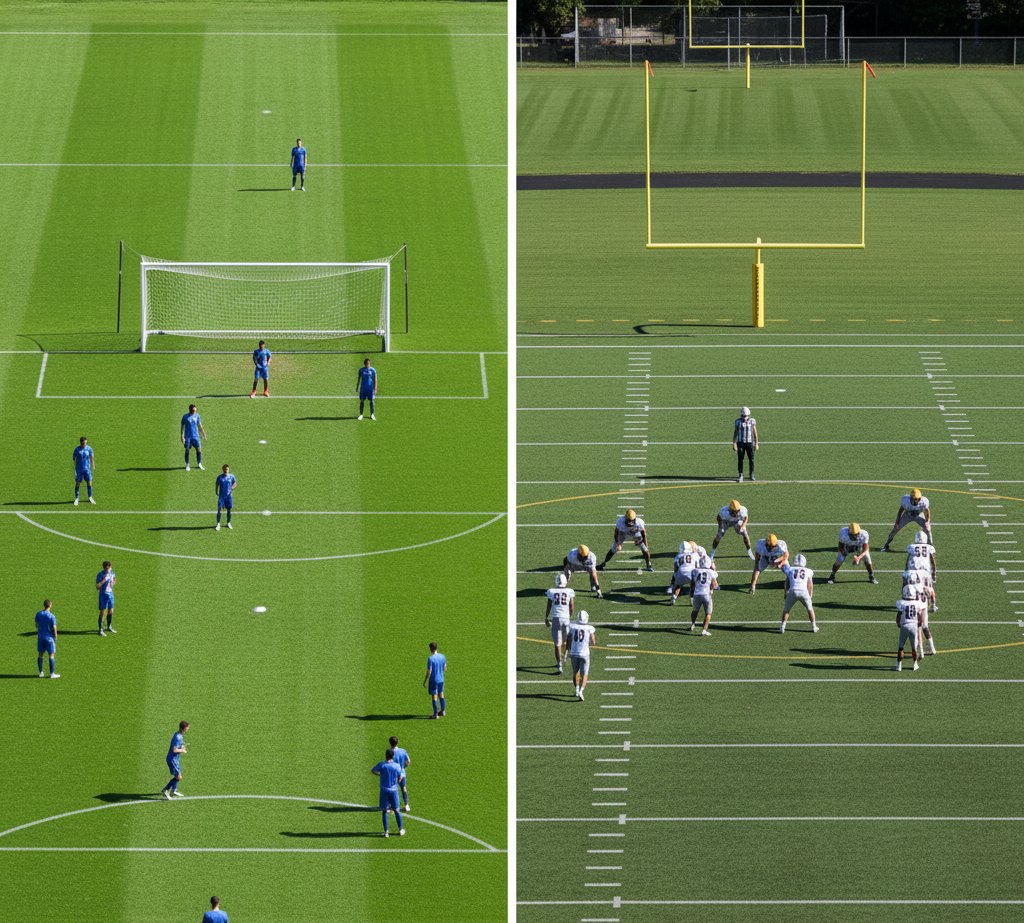When most people see a large green field with white markings, they often assume it can be used for multiple sports. In fact, many fans ask, “Is a soccer field the same as a football field?” At first glance, the two look very similar—they are both rectangular, grass (or turf) fields with goals at either end. But while they share similarities, the dimensions, markings, and purposes of soccer fields and football fields are very different.
In this article, we’ll break down everything you need to know about soccer field vs. football field comparisons, including their sizes, markings, goals, and why these differences matter.
1. Soccer Field vs. Football Field Dimensions
One of the biggest differences between a soccer field and a football field is size.
Soccer Field Dimensions
According to FIFA (the governing body of soccer), a regulation soccer field must be:
Length: 100 to 130 yards (90–120 meters)
Width: 50 to 100 yards (45–90 meters)
For international matches, the range is tighter:
Length: 110 to 120 yards (100–110 meters)
Width: 70 to 80 yards (64–75 meters)
This means soccer fields can vary significantly depending on the competition and the stadium.
Football Field Dimensions
In contrast, American football fields are standardized across all levels (high school, college, and NFL):
Length: 120 yards (100 yards of play + two 10-yard end zones)
Width: 53 ⅓ yards (160 feet)
Key difference: A football field is narrower than most soccer fields. While both can be about the same length, soccer fields are usually much wider.
2. Markings on the Field
Another major difference comes from the markings used to guide play.
Soccer Field Markings
Center Circle – 10-yard radius where play begins and restarts.
Penalty Box – 18 yards from the goal line, where penalties and goalkeeper actions take place.
Goal Box – Smaller 6-yard box for goal kicks.
Corner Arcs – Quarter-circle markings for corner kicks.
Halfway Line – Splits the field in two halves.
Soccer markings are minimal, designed to keep the game flowing with fewer interruptions.
Football Field Markings
Yard Lines – Marked every 5 yards across the field.
Hash Marks – Narrow lines used for ball placement.
End Zones – 10 yards deep, used for scoring touchdowns.
Goal Line – Where the ball must cross to score.
Football requires precise measurement for downs, yardage, and scoring, which is why the markings are much more detailed.
3. Goals vs. Goalposts
Soccer Goals: A rectangular frame 8 feet high and 24 feet wide. The entire ball must cross the goal line to score.
Football Goalposts: Two upright posts with a crossbar, standing 10 feet high with posts rising another 20+ feet. Scoring involves carrying the ball into the end zone (touchdown) or kicking it through the uprights (field goal).
👉 Key difference: Soccer scoring is about accuracy and placement, while football allows both running/passing into a zone and kicking between posts.
4. Playing Surface
Both sports use either natural grass or artificial turf, especially in multipurpose stadiums. However, soccer fields generally require a wider playing area, while football fields are marked specifically for tactical yardage.
In many U.S. stadiums, a soccer pitch is laid out on top of a football field, often extending past the sidelines to meet FIFA’s width requirements.
5. Can You Play Soccer on a Football Field?
Technically, yes—you can play soccer on a football field, and this is often done for youth or recreational games. However, the experience is not ideal:
The narrow width of a football field (53 ⅓ yards) barely meets FIFA’s minimum requirement (50 yards) but falls short of the recommended width (70–80 yards).
The football markings can confuse players and officials during soccer matches.
The playing style of soccer, which relies on space, is restricted on a football field.
This is why professional soccer matches in the U.S. often require temporary field adjustments or stadium modifications.
6. Why the Fields Are Different
The fields reflect the nature of each sport:
Soccer emphasizes continuous play, spacing, and movement → wider fields encourage fluid passing and open gameplay.
Football emphasizes structured downs, yardage, and scoring zones → standardized fields ensure fairness and strategy.
In other words, the field design directly supports the sport’s rules and flow.
7. Quick Comparison: Soccer Field vs. Football Field
| Feature | Soccer Field | Football Field |
|---|---|---|
| Length | 100–130 yards | 120 yards (100 + end zones) |
| Width | 50–100 yards (70–80 preferred) | 53 ⅓ yards |
| Markings | Minimal (center circle, boxes) | Detailed (yard lines, hash marks) |
| Goals/Scoring | 8×24 ft rectangular goals | End zones + uprights |
| Flexibility | Dimensions can vary | Dimensions fixed |
8. Final Answer: Are They the Same?
So, is a soccer field the same as a football field?
The answer is no. While they are both large, rectangular fields with green playing surfaces, they differ in size, markings, goals, and purpose. Soccer fields are usually wider and more flexible in dimensions, while football fields are strictly standardized for precise gameplay.
If you ever see a soccer game played on a football field, now you’ll understand why it looks tighter and why extra markings can be confusing.

